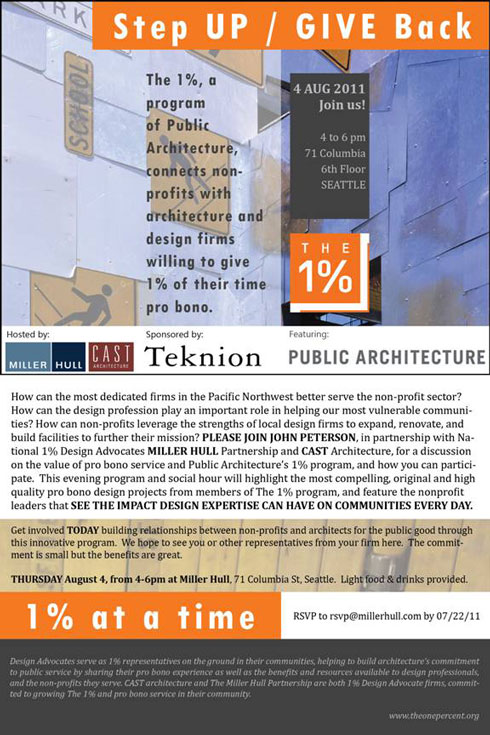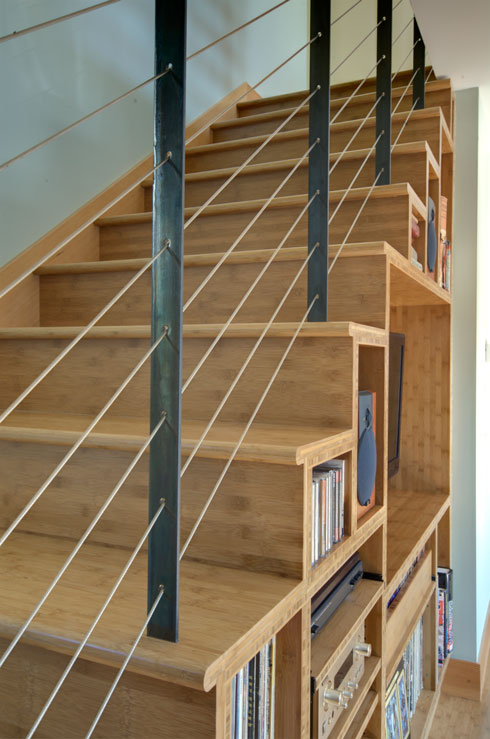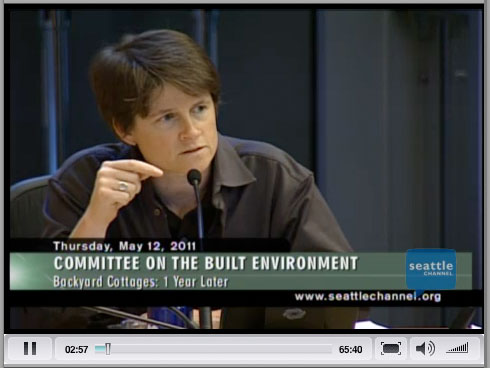 CAST architecture recently participated in a Seattle City Council discussion regarding backyard cottages. The meeting began with a presentation of backyard cottage statistics that were gathered during the first year of the city wide backyard cottage ordinance. Following the presentation participants discussed working with the ordinance in practice and suggested potential improvements that could be made to the ordinance.
You can view a video of the entire discussion at seattlechannel.org:
Backyard Cottages: 1 Year Later
CAST architecture recently participated in a Seattle City Council discussion regarding backyard cottages. The meeting began with a presentation of backyard cottage statistics that were gathered during the first year of the city wide backyard cottage ordinance. Following the presentation participants discussed working with the ordinance in practice and suggested potential improvements that could be made to the ordinance.
You can view a video of the entire discussion at seattlechannel.org:
Backyard Cottages: 1 Year Later
There is also a backyard cottage annual report available to download from the DPD's website: Backyard Cottages Annual Report - April 2011
Of particular interest was the number of cottages permitted in the first year (57) and their relatively even distribution throughout the city. One of the primary concerns opponents had expressed in opposition to the ordinance was a fear that dense concentrations of cottages would "take over" single family neighborhoods causing widespread parking and privacy issues. The fear was so potent and adamantly expressed that at one point during the development of the ordinance city council members considered placing limits on the number of permits per year (50) and limits on the number of cottages allowed in any given area. Thankfully, neither limit was written into the code and the fears have been proven to be unjustified thus far.
A few other interesting issues that came to the surface during the discussion were:
- The relatively high costs of constructing a backyard cottage makes it difficult for home owners to see a return on their investment if they hope to use a cottage to generate rental income. In general it was felt that backyard cottages were an important new housing typology for the city and that the cottages are a valuable addition to the city's rental stock. It was proposed that the city should consider incentives that would help lower the cost of constructing a cottage and help encourage their creation. A reduced permit fee and property tax credits are two areas I think the city should review.
- The feeling that the off street parking requirements (2 spaces) was in most cases unnecessary and to the detriment of green space and usable yards. One idea put forth was to loosen the parking requirements by making it easier to obtain a parking waiver on streets where parking is not an issue.
- The base height limit was thought to be a bit too low and creates unreasonable difficulties for the construction of two story structures. During the public comment portion of the meeting architect Jim Burton suggested changing the datum to which the base height could be measured (top of plate) to add a bit to the base height limit and encourage homeowners to exceed minimum requirements for insulating roofs and ceilings. The overall height limit was thought to be adequate with the exception of the following issue:
- The current ordinance sets the height limit to 15' above an existing home. This was thought to be problematic and unfair in the case where the property owner's lot has a significant slope up behind the existing home.
- The current ordinance does not allow for a backyard cottage to be built on a through lot (a lot with a street on both the front and rear lot lines of a property). This was generally thought to be a mistake in the writing of the ordinance and that the ordinance should be revised to allow cottages on through lots.
All in all it was a fun and informative meeting. Kudos to the city employees key in the development of the ordinance and to Sally Clarke and the city council for passing the ordinance unanimously. After the first year of real world testing the ordinance has proven to be a resounding success.
 The Widner Cottage is going to be open to the public twice this summer for tours:
The Widner Cottage is going to be open to the public twice this summer for tours:
First, the Phinney Neighborhood Association's Home and Garden Tour will roll through on June 12th, from 11-4 pm (see link).
Second, the Cottage will be featured as the AIA Seattle's Open House on July 17th from noon to 3 pm. Â More information here. Â As part of the tour, the house will be published in Seattle Magazine, in the Northwest Home section in July.
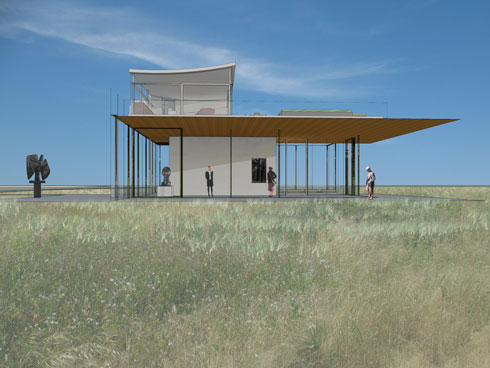 CAST architecture was featured in a couple of articles in the latest Forum magazine (published by AIA Seattle):
CAST architecture was featured in a couple of articles in the latest Forum magazine (published by AIA Seattle):
Sunset Substation Park was highlighted in an article, Ideas Toward a Renewable City, by Kate Cudney and Tom Mulica.
In a second article, New Edge/New Blood: Â Refreshing reminders from ten young firms on keeping your competitive edge, by David Spiker, I talk about our use of blogging as a tool to highlight recent work and causes such as Backyard Cottages and reforming the Multifamily code. Â Hopefully it is giving people a broader understanding, beyond the glossy portfolio, of the values that drive our designs.
One of our clients is documenting the process of transforming their bungalow with passive solar addition  (Design brief here) with a image laden blog. Check it out!
Stefan and I attended a conference put on by Passive House Northwest at Evergreen State College on Friday and I feel like we got a bit more of the nuance of the standard, understanding of more of the nerdy building science, as well as a chance to look at first hand some of new projects being brought to the US market. A little more background: Passive House is a concept developed by the PassiveHaus Institute in Germany. They developed the tools that are used to model performance, and do the training and certification of Passive House consultants. While there are about 30,000 PH projects worldwide, the US rollout has led to a few complications.
First, within the name, there are two inherent misconceptions:Â that they are passive solar houses, and that it is a strategy for houses (since the direct german translation for haus would be 'building' , it's easy to overlook the impact on larger institutional and commercial projects).
Second, the Passive House standard was developed in Germany, and there are concerns that it doesn't address other climates. In very cold climates, for example, the PH standard would call for an impractical amount of insulation, while in hotter areas, a code compliant house with an interior air seal might make the cut.
Third, the software is a black box, and as one conference goer pointed out, the Northwest is home to a lot of DIY building science 'rogues' who want to see into the box, fiddle and tweak the system to optimize it for our climate. It's a bit of a culture clash manifesting itself in the black box/open source conversation. Plus it is proprietary, so I feel a little bit of the same resistance I have to LEED and the USGBC.
Fourth, the spent energy metric is based on an area measurement. Since the US first adopters are building houses, and on the small side, the bar is pretty high because the same energy hogs populate big and small homes alike. Joe Giampetro has recently finished his 'Mini-B' passive house--essentially a small DADU, so it can be done, but there is no inherent reward for building not so big.
The flip side of the argument would be that we shouldn't be building single family detached at all. Urban Olympic, our multifamily Passive House, seen in the prior post, will be an excellent data point to compare how the overall size of the building affects the energy model's performance and cost of construction.
All in all, if you are a building science nerd, I'd recommend the next event, scheduled for June 17th. Regardless of your commitment to green building, the underlying idea is powerful, and will have a big impact on the industry over the next 20 years.
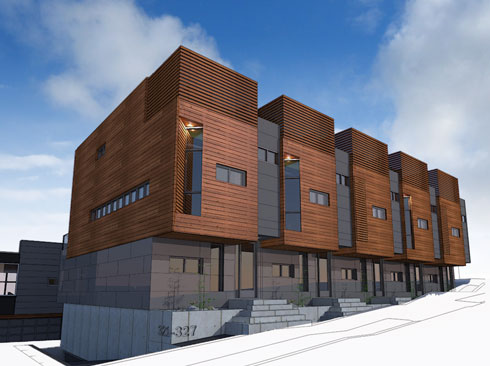 Urban Olympic is a community of 9 townhouses, and will  mark a couple of firsts for us:  our first Passive House project and also our first project under the new Seattle multifamily code.
Urban Olympic is a community of 9 townhouses, and will  mark a couple of firsts for us:  our first Passive House project and also our first project under the new Seattle multifamily code.
Passive House is a rigorous green building standard focused on exclusively on energy consumption, energy efficiency and air quality. They are super insulated, almost airtight, and therefore need very little energy input to heat (up to a 90% reduction of the energy used by a typical code compliant house).  The heat from equipment, people and lighting retained within the insulated building envelope essentially replaces the furnace/boiler as the primary heat source. Fresh air is conditioned through a Heat Recovery Ventilator (HRV) with the exhausted air. Although solar gain does factor into the equation, Passive Houses are not passive solar houses.
Urban Olympic, to my knowledge, will be the first multifamily Passive House in the United States.
 Matt Hutchins from our office will be leading the AIA how to work with an architect discussion at the seattle AIA office this Saturday. Â If you are considering a remodel, addition or new construction, and are interested about the process and value proposition of working with an architect please consider attending this talk from 9:30 to noon on Saturday the twelfth. Â See below for more info:
Matt Hutchins from our office will be leading the AIA how to work with an architect discussion at the seattle AIA office this Saturday. Â If you are considering a remodel, addition or new construction, and are interested about the process and value proposition of working with an architect please consider attending this talk from 9:30 to noon on Saturday the twelfth. Â See below for more info:
Making your Project Happen:
How to Select and Work with an Architect
Trying to figure our how to make the most of your budget? Dreaming about a project and not sure where to start? Curious about green design or how to plan for your family's changing needs?
Whether your project is a small remodel or new construction—or if you are just curious about the design process—AIA architects can help. Join Matt Hutchins AIA and Don Larkin AIA for an information-packed seminar on the basics of the design and construction project including budget advice, tips for hiring the right contractor, what to expect, and how you and your architect can work together to make the most of any project.
Saturday March 12, 2011 9:30am - noon AIA Seattle, 1911 First Avenue Cost:Â Â $15 To register, click here: www.aiaseattle.org/node/5311
PRESENTERS
Matt Hutchins
Matt Hutchins is a licensed architect who graduated with Honors from the University of Colorado and Arizona State University. Prior to CAST, Matt practiced in Boulder, Aspen and Phoenix, designing custom residential, mixed-use and commercial buildings. He has taught design drawing at the University of Washington School of Architecture, undergraduate design studios at Arizona State University, and has written articles for Building Edge Magazine. He is an artist with a primary focus in wood block printmaking. http://www.castarchitecture.com
Don Larkin AIA
Don Larkin is a licensed architect specializing in custom residential architecture.  He is the owner of an architectural design firm in Newcastle, Washington, and designs custom homes and remodels throughout the state of Washington.  With over 20 years of residential experience, he designs projects of all styles, sizes and budgets to meet the unique needs of the client.  He encourages client participation throughout the design process and considers the client the most valuable member of the design team.  To view photos of his work, please visit his website at www.DonLarkinArchitect.com.
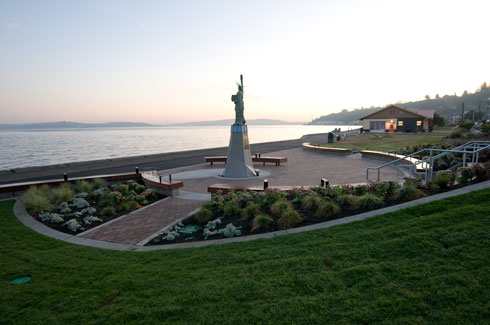
We had about 15 at the AIA/CORA Pro Bono Design panel discussion. Â Joining me on the panel was Rachel Minnery from Environmental Works, and Geoff Piper from Global Studio.
A couple of valuable points that came out of our discussion:
1. Â Pro bono work is different than being a volunteer. Â Pro bono service is the application of our professional abilities, judgement, experience, creativity to work for the public good. Â Volunteering is a valuable component of civic life, such as working for Habitat for Humanity, but is probably relatively unskilled labor.
2. Â Vet potential clients--they need to have the community connection, stability, and personnel to carry out the mission, because our work as architects is really just the beginning for any pro bono project. Our work may be the seed, but it takes a committed organization to make the investment a reality.
3. Â Treat pro bono projects just as you would any other project in the office. Â Otherwise, you're doing both your client and our profession a disservice by treating it as a less than serious undertaking. Â That means contracts, liability, life safety, and solid construction documents.
4. Â Work on projects/issues that you are interested in. Â First it will help make the commitment easier to make, help you build experience in that area, and help to show people (and potential clients) where your heart lays.
As architects, we're often not in the driver's seat with regards to the project, but with pro bono, you have to take up the mantle of a shared mission with that community group or cause, and part of the compensation for your investment in time is taking the project where you think it should go. Â Your vision may be underrated in the private sector, but essential to many non-profits trying to raise funds. Â It is a wonderful opportunity to be entrepreneurial, Â make connections with a larger community, and act not only as problem solvers, but problem identifiers.

